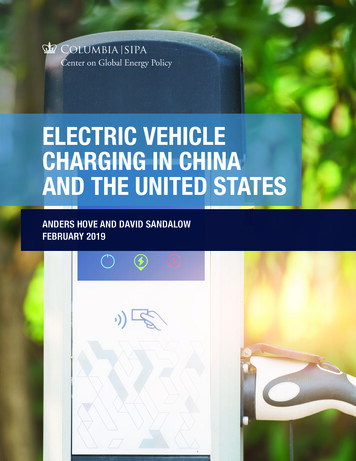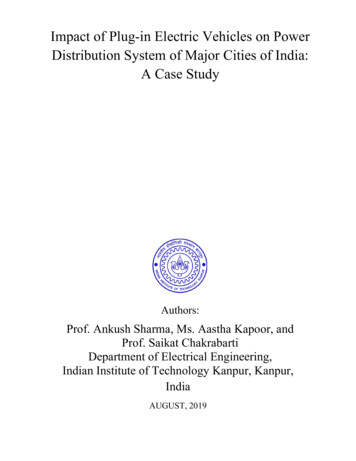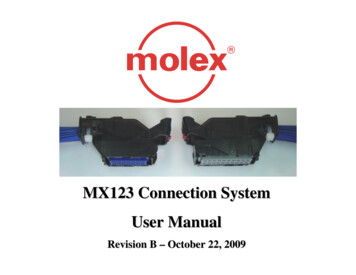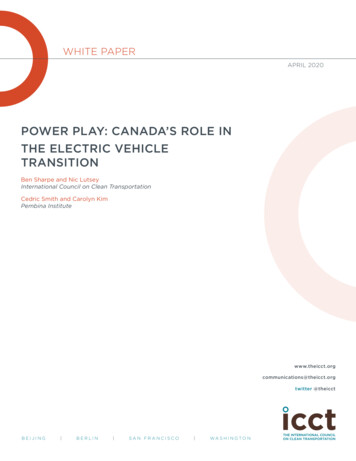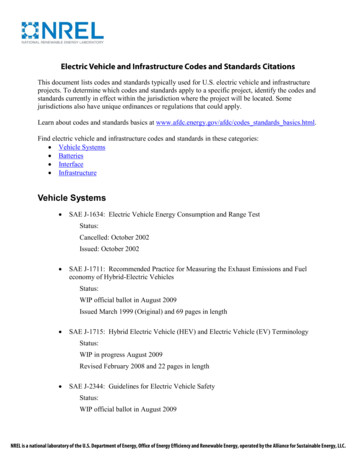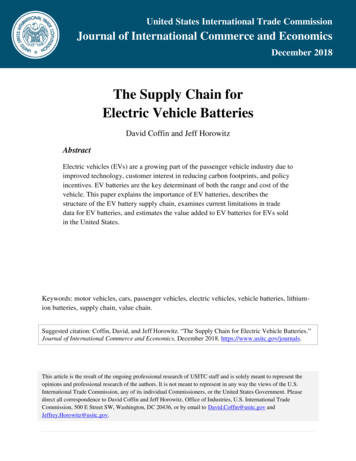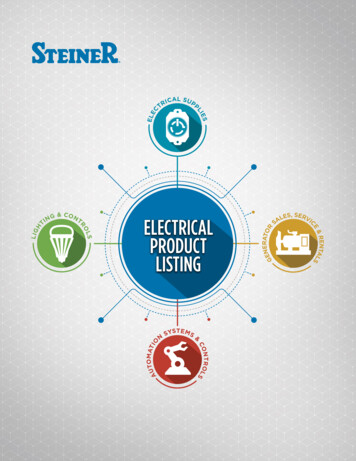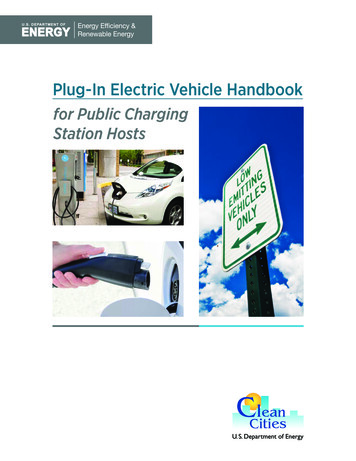
Transcription
Plug-In Electric Vehicle Handbookfor Public ChargingStation Hosts
Plug-In Electric Vehicle Handbook for Public Charging Station Hosts2Photo from George Beard, Portland State University, NREL/PIX 18564Clean Cities Helps Establish PEVCharging StationsEstablishing plug-in electric vehicle (PEV)charging stations requires unique knowledgeand skills. If you need help, contact your localClean Cities coordinator. Clean Cities is theU.S. Department of Energy’s flagship alternative-transportation deployment initiative. It issupported by a diverse and capable team ofstakeholders from private companies, utilities,government agencies, vehicle manufacturers,national laboratories, and other transportation-related organizations. These stakeholders, organized into nearly 100 Clean Citiescoalitions nationwide, are ready to help withspecific charging station challenges. Contactyour local coordinator by visiting the CleanCities website at www.cleancities.energy.gov.Table of ContentsIntroduction . . . . . . . . . . . . . . . . . . . . . . . . 3PEV Basics . . . . . . . . . . . . . . . . . . . . . . . . . 4Charging Basics . . . . . . . . . . . . . . . . . . . . . 6Benefits and Costs ofHosting a Charging Station . . . . . . . . . . . 9Charging StationLocations and Hosts . . . . . . . . . . . . . . . . . 12Ownership and Payment Models . . . . . . 14Installing and MaintainingCharging Stations . . . . . . . . . . . . . . . . . . . 15Electrifying the Future . . . . . . . . . . . . . . . 19AcknowledgementThanks to the Electric Vehicle Infrastructure TrainingProgram for assisting with the production of this handbook.See merThis report was prepared as an account of work sponsored by an agency of the United States government. Neither the United States government norany agency thereof, nor any of their employees, makes any warranty, express or implied, or assumes any legal liability or responsibility for the accuracy, completeness, or usefulness of any information, apparatus, product, or process disclosed, or represents that its use would not infringe privatelyowned rights. Reference herein to any specific commercial product, process, or service by trade name, trademark, manufacturer, or otherwise does notnecessarily constitute or imply its endorsement, recommendation, or favoring by the United States government or any agency thereof. The views andopinions of authors expressed herein do not necessarily state or reflect those of the United States government or any agency thereof.
Plug-In Electric Vehicle Handbook for Public Charging Station Hosts3IntroductionYou’ve heard about the new generation of plug-inelectric vehicles (PEVs) like the Chevy Volt andNissan Leaf. You manage a location that couldhost a PEV charging station — such as a retailbusiness, office or municipal building, utility, orparking garage — and you’re wondering how youcan be part of the electric transportation revolution. This handbook is for you. If you have aproperty suitable for hosting an electric chargingstation, you are perfectly positioned to contributeto — and benefit from — the fast-growing PEVsector. This handbook answers your basic questions about PEVs and charging infrastructure andpoints you to the additional information you need todecide about participating in this new venture.More than 100 years ago, all-electric vehicles (EVs)held much of the U.S. car market, but their popularitywaned as the interest in conventional cars with internal combustion engines (ICEs) rose. The ICE vehiclehad a longer driving range, petroleum fuel costs weredeclining, and the introduction of the electric starterand manufacturing assembly line improved the usability and affordability of ICE vehicles. Gasoline- anddiesel-powered ICE vehicles ended up dominatingtransportation in the 20th century.However, concerns about the environmental impactsof conventional ICE vehicles sparked a PEV renaissance at the end of the 20th century. In 1990, California passed the nation’s first zero emission vehiclemandate, putting the state at the forefront of thatdecade’s deployment of PEVs such as the GeneralMotors EV1, Chrysler EPIC, Ford Ranger EV, andToyota RAV4 EV. Many vehicles from this generation were discontinued in the early 2000s, and thenumber of non-residential charging stations — whichhad peaked at nearly 900 in 2002 — dwindled toabout 400 by 2008. However, California’s visionhelped set the stage for the next generation of PEVsand charging stations.Today, PEVs are back and ready to competewith — and complement — the ubiquitous ICE technology. First, advances in electric-drive technologiesenabled commercialization of hybrid electric vehicles (HEVs), which integrate an ICE or other powersource with batteries, regenerative braking, and anelectric motor to boost fuel economy. Continuedtechnological advances have spawned plug-in HEVsPhoto from Electric Vehicle Infrastructure Training ProgramKey AcronymsEVs (all-electric vehicles) are powered only by oneor more electric motors. They receive electricity byplugging into the grid and store it in batteries. Theyconsume no petroleum-based fuel while drivingand produce no tailpipe emissions.EVSE (electric vehicle supply equipment) delivers electrical energy from an electricity source tocharge a PEV’s batteries. It communicates with thePEV to ensure that an appropriate and safe flow ofelectricity is supplied. EVSE units are commonlyreferred to as “charging stations.”HEVs (hybrid electric vehicles) combine an ICE orother propulsion source with batteries, regenerativebraking, and an electric motor to provide high fueleconomy. They rely on a petroleum-based or analternative fuel for power and are not pluggedin to charge. HEV batteries are charged by theICE or other propulsion source and during regenerative braking.ICEs (internal combustion engines) generatemechanical power by burning a liquid fuel (such asgasoline, diesel, or biofuels) or a gaseous fuel (suchas compressed natural gas). They are the dominantpower source for on-road vehicles today.PEVs (plug-in electric vehicles) derive all or part oftheir power from electricity supplied by the electricgrid. They include EVs and PHEVs.PHEVs (plug-in hybrid electric vehicles) use batteriesto power an electric motor, plug into the electric gridto charge, and use a petroleum-based or an alternative fuel to power an ICE or other propulsion source.
Plug-In Electric Vehicle Handbook for Public Charging Station Hosts4(PHEVs), which integrate small ICEs (or other powersources) and large, grid-chargeable batteries that enableall-electric driving ranges of 10 to 40 miles or more.Advanced technologies have also enabled manufacturers to introduce a new generation of EVs that don’t usean ICE at all. At the same time, charging station technologies have evolved to facilitate a range of chargingoptions and business models.Only a few models of new-generation PEVs are availabletoday. However, because of the benefits they offer, PEVmarket penetration and availability are growing quickly.President Obama set a goal of having 1 million PEVson the road by 2015. Many of these vehicles will chargeprimarily at drivers’ homes, but a large and widely distributed network of public and workplace charging stations is essential for providing the convenience, range,and confidence required by the majority of drivers. Theproliferation of non-residential charging units has accelerated already — surpassing 7,000 in 2012 — with thehelp of government-supported deployment projects. Asa potential station owner or host, you have the opportunity to benefit from this trend while helping drive PEVdeployment in the United States.PEV BasicsBefore learning about charging stations, it’suseful to learn a little about the vehicles anddrivers that will use them. What makes a PEVa PEV is the ability to charge from an off-boardelectric power source — PEVs can be “pluggedin.” This feature distinguishes them from HEVs,which supplement power from an ICE or otherpropulsion source with battery power butcannot be plugged in. There are two basic typesof PEVs: EVs and PHEVs.All-Electric Vehicles (EVs)EVs (also called battery-electric vehicles, orBEVs) use batteries to store the electrical energythat powers one or more motors. The batteries are charged by plugging the vehicle into anelectric power source. In addition, EVs can becharged in part by regenerative braking, whichgenerates electricity from some of the energynormally lost when braking. It’s as simple asthat — EVs have no ICEs and produce no tailpipe emissions.Under the hood of a Nissan Leaf. An EV contains no ICE; instead,the battery supplies electricity to the electric motor. Photo fromMargaret Smith, DOE, NREL/PIX 18215Today’s EVs typically have a shorter range than conventional vehicles have. Most light-, medium-, and heavyduty EVs are targeting a range of about 100 miles ona fully charged battery. The range depends in part ondriving conditions and habits.The time required to charge depleted batteries — whichcan range from less than 30 minutes to almost a fullday — depends on the size and type of the batteries,as well as the type of charging equipment used. Learnmore about charging in the Charging Basics section.Neighborhood electric vehicles (NEVs), also called lowspeed vehicles, are a type of EV with range and speedlimitations. NEVs are commonly used for neighborhood commuting, light hauling, and delivery. They areoften limited to use on roads with speed limits up to 35miles per hour, making them ideal for college campuses and similar applications. There are also specialtyEVs, such as airport ground support equipment andpersonal transporters, which are not intended for roaduse. Although these types of vehicles are valuable forthe niches they serve, this handbook focuses on EVsdesigned for highway use.
Plug-In Electric Vehicle Handbook for Public Charging Station HostsWhy Drivers Choose PEVsThe reasons drivers choose PEVs range from adesire to improve the world to a desire to savemoney. The following list of PEV benefits illustrates why the demand for PEVs — and thus forcharging stations — has been growing rapidly.High Fuel Economy, Low Operating Cost: PEVsare highly efficient, and they have much loweroperating costs compared with conventionalgasoline and diesel vehicles.Flexible Fueling: Compared with conventionalvehicles, PEVs offer additional fueling options,including charging at home, work, commercialcharging stations, other public locations, privatefleet facilities, or a combination of these sites.High Performance: Today’s PEVs are state-of-theart highway vehicles ready to match or surpass theperformance of their conventional gasoline anddiesel counterparts.Low Emissions: Compared with conventional vehicles,PEVs typically produce lower levels of smog-formingemissions (such as nitrogen oxides), other pollutantsharmful to human health, and greenhouse gases.Energy Security: Because almost all U.S. electricity isproduced from domestic coal, nuclear power, naturalPlug-In Hybrid Electric Vehicles (PHEVs)PHEVs (sometimes called extended range electricvehicles, or EREVs) use batteries to power an electricmotor and use another fuel, such as gasoline or diesel,to power an ICE or other propulsion source. Poweringthe vehicle some of the time with electricity from thegrid cuts petroleum consumption and tailpipe emissions,compared with conventional vehicles. When running ongasoline, PHEVs, like HEVs, consume less fuel and typically produce lower emissions than similar ICE vehicles.PHEVs have larger battery packs than HEVs, providingan all-electric driving range of about 10 to 40-plus milesfor current light-duty models. During typical urbandriving, most of a PHEV’s power can be drawn fromstored electricity. For some urban fleet applications, aPHEV could be driven on all-electric power all day andthen charged at night or even during a down time likelunch. The ICE powers the vehicle when the battery ismostly depleted, during rapid acceleration, or whenIn all-electric mode, PEVs produce no tailpipe emissions.PEV life cycle emissions are minimized when their source ofelectricity comes from nonpolluting resources like wind andsunlight. Photo from Atlantic County Utilities Authority, NREL/PIX 18311gas, and renewable sources, using PEVs instead ofconventional vehicles reduces U.S. dependence onimported petroleum.Compliance with Fleet Requirements: PEVs canhelp fleets comply with federal, state, and local transportation policies.intensive heating or air conditioning is required. Someheavy-duty PHEVs work the opposite way, with the ICEused for driving to and from a job site and electricityused to power the vehicle’s equipment or control thecab’s climate while at the job site. Because the vehiclewould otherwise be idling at the job site for poweringequipment or climate control, this PHEV strategy canresult in significant fuel savings.Like EVs, PHEVs can be plugged into the grid andcharged, although the time required to charge depletedbatteries is typically shorter for PHEVs, because mosthave smaller battery packs. In addition, battery charge isaugmented by a PHEV’s ICE and regenerative braking.PHEV fuel consumption depends on the distance drivenbetween battery charges. For example, if the vehicle isnever plugged in to charge, fuel economy will be aboutthe same as for a similarly sized HEV. If the vehicle isdriven less than its all-electric range and plugged in tocharge, it may be possible to use only electric power.5
Plug-In Electric Vehicle Handbook for Public Charging Station Hosts6PEV AvailabilityAs of the time this handbook was written, only afew light-duty PEVs were commercially available.PEV technology is just beginning to make inroadsinto the U.S. vehicle market, but the number of available vehicles is predicted to grow quickly. For comparison, only two HEV models were available in thelate 1990s, compared with 29 models today. To findcurrently available PEVs, use the AFDC Light-DutyVehicle Search (www.afdc.energy.gov/afdc/vehicles/search/light). Learn about anticipated PEV introductions from the Electric Drive Transportation Association (www.electricdrive.org) and html andwww.fueleconomy.gov/feg/evnews.shtml).A larger number of medium- and heavy-duty PEVmodels are currently available, most of which are EVs.Applications include delivery trucks, step vans, transitand shuttle buses, and utility trucks. To find currentlyavailable medium- and heavy-duty PEVs, use the AFDCHeavy-Duty Vehicle and Engine Search n addition to a limited number of PEV models, earlyPEV introductions (starting in 2010) have been limitedto select geographic areas to match dealer and servicepreparation. However, it is expected that at least somePEVs will soon be available from select dealershipsin all 50 states. Because of the popularity and limitedinitial production of PEVs, there may be a wait timeinvolved in obtaining these vehicles.Figure 1. A Chevy Volt charges up with public Level 2 EVSE at Los Angeles International Airport. Photo from Coulomb TechnologiesCharging BasicsIf you want to establish a charging station, you need toknow about electric vehicle supply equipment (EVSE,Figure 1). There are various types of EVSE —which differbased on communication capabilities and how quicklythey can charge a vehicle — and EVSE can be installed athomes, workplaces, private fleet facilities, and public stations. This section describes the typical EVSE options.Types of Charging Equipment (EVSE)EVSE is the equipment used to deliver electrical energyfrom an electricity source (such as the electricityrunning to the electrical outlets at a business) to a PEV.EVSE communicates with the PEV to ensure that anappropriate and safe flow of electricity is supplied.Typical Charging RatesThe rate at which charging adds range to a PEVdepends on the vehicle, the battery type, and thetype of EVSE. The following are typical rates for alight-duty vehicle:Level 1: 2 to 5 miles of range per hour of chargingLevel 2: 10 to 20 miles of range per hour ofchargingDC fast charging: 60 to 80 miles of range in 20minutes of charging
Plug-In Electric Vehicle Handbook for Public Charging Station HostsEVSE for PEVs is classified into several categoriesby the rate at which the batteries are charged. Twotypes — Level 1 and Level 2 — provide alternatingcurrent (AC) electricity to the vehicle, with the vehicle’sonboard equipment (charger) converting AC to thedirect current (DC) needed to charge the batteries.The other type — DC fast charging — provides DCelectricity directly to the vehicle. Charging times rangefrom less than 30 minutes to 20 hours or more, basedon the type or level of EVSE; the type of battery, itsenergy capacity, and how depleted it is; and the sizeof the vehicle’s internal charger. EVs generally havemore battery capacity than PHEVs, so charging afully depleted EV takes longer than charging a fullydepleted PHEV.Many medium- and heavy-duty PEV manufacturersare adopting light-duty charging standards or commercially available standards developed for other uses.However, some manufacturers are introducing alternative charging configurations in their medium- andheavy-duty PEVs, so EVSE options and performancemay be different for these vehicles.7installation of charging equipment and a dedicatedcircuit of 20 to 80 amp (A) depending on the EVSErequirements (Figure 2). Level 2 equipment uses thesame connector on the vehicle as Level 1 equipment.Based on the battery type, charger configuration, andcircuit capacity, Level 2 charging adds about 10 to 20miles of range to a PEV per hour of charging time.DC Fast ChargingDC fast-charging EVSE (480-V AC input to the EVSE)enables rapid charging at sites such as heavy traffic corridors and public fueling stations (Figure 3, next page).A DC fast charger can add 60 to 80 miles of range to aPEV in 20 minutes.Utility240-V ACControl DeviceCordLevel 1Level 1 EVSE provides charging through a 120-volt(V) AC plug and requires electrical installation per theNational Electrical Code. Most, if not all, PEVs willcome with a Level 1 EVSE cordset so that no additionalcharging equipment is required. On one end of the cordis a standard, three-prong household plug (NEMA 5-15connector). On the other end is a J1772 standard connector (see the Connectors and Plugs section on page 8),which plugs into the evel 1 typically is used for charging when there is onlya 120-V outlet available, such as at some residentiallocations. Based on the battery type and vehicle, Level 1charging adds about 2 to 5 miles of range to a PEV perhour of charging time.Level 2Level 2 EVSE can easily charge a typical EV batteryovernight, and it will be a common installation forhome, workplace, fleet, and public facilities. Level2 EVSE offers charging through a 240-V (typical inresidential applications) or 208-V (typical in commercial applications) electrical service. These installationsare generally hard-wired for safe operation (although awall plug connection is possible). Level 2 EVSE requiresFigure 2. Level 2 charging schematic.Source: eTec (2010), Electric Vehicle Charging Infrastructure Deployment Guidelines for the Oregon I-5 Metro Areas of Portland, Salem,Corvallis and Eugene. EV Project publication (www.theevproject.com/documents.php). Illustration by Dean Armstrong, NREL
Plug-In Electric Vehicle Handbook for Public Charging Station Hosts8Utility480-V3-PhaseChargerCordDC FastCharging ConnectorDC FastCharging InletEVSEEVCouplerFigure 4. The standard SAE J1772 EVSE connector fits intothe standard SAE J1772 receptacle. Photo by Andrew Hudgins,BatteryFigure 3. DC fast charging schematic.Source: eTec (2010). Electric Vehicle Charging Infrastructure Deployment Guidelines for the Oregon I-5 Metro Areas of Portland, Salem,Corvallis and Eugene. EV Project publication, www.theevproject.com/NREL/PIX 17634Figure 5. The standard J1772 receptacle (right) can receivecharge from Level 1 or Level 2 equipment. The CHAdeMODC fast charge receptacle (left) uses a different type ofconnector. Photo by Andrew Hudgins, NREL/PIX 19558documents.php. Illustration by Dean Armstrong, NRELInductive ChargingInductive-charging EVSE, which uses an electromagnetic field to transfer electricity to a PEV without acord, is still being used in some areas where it wasinstalled for EVs in the 1990s. Currently available PEVscannot use inductive charging, although SAE International is working on a standard that may apply to PEVsin the future.Connectors and PlugsMost modern EVSE and PEVs have a standard connector and receptacle based on the SAE J1772 standard developed by SAE International (Figure 4). Anyvehicle with this receptacle can use any Level 1 orLevel 2 EVSE. All major vehicle and charging systemmanufacturers support this standard, which shouldeliminate drivers’ concerns about whether their vehiclesare compatible with available charging infrastructure.Most currently available PEVs that are equipped toaccept DC fast charging are using the CHAdeMO connector, developed in coordination with Tokyo ElectricPower Company, which is not standard in the UnitedStates. Manufacturers may offer the CHAdeMO DCfast charge receptacle (Figure 5) as an option on fastcharge capable vehicles until a standard is in place. SAEInternational is also working on a “hybrid connector”standard for fast charging that adds high-voltage DCpower contact pins to the J1772 connector, enabling useof the same receptacle for all levels of charging.
Plug-In Electric Vehicle Handbook for Public Charging Station HostsBenefits and Costs ofHosting a Charging StationNow that you know the basics about PEVs and charging infrastructure, this section helps you explore thebenefits and costs of hosting a charging station.1 Totailor this benefit-cost exploration to your situation,use the Rocky Mountain Institute’s Project Get ReadyCharging Infrastructure Tool, available at www.rmi.org/pgr resources#infrastructure.Charging Station BenefitsThere are many benefits to owning or hosting a charging station, which depend on your site characteristicsas well as your goals and values. For example, a retailbusiness may host a charging station to increase customer visits and revenue, whereas a municipality mayhost a station for the public health benefits associatedwith increased PEV use. Each benefit in the following list is — or may become — available to one or moretypes of station host.Customer Attraction and Retention, Corporate BrandingOffering charging is a direct way to attract and retainnew, PEV-driving customers. In addition, many consumers believe it is important to purchase productswith environmental benefits and to frequent environmentally responsible companies. Hosting a chargingstation is a highly visible way to state your organization’s environmental values, which may help contributeto a “green” image that attracts and retains customerswho share these values.User Charging and Parking FeesRaleigh, North Carolina, is among the many U.S. citiesinstalling EVSE in public places. Photo from Kathy Boyer,Triangle Clean Cities Coalition, NREL/PIX 18520Charging-station hosts have the opportunity to generate revenue directly from people who use their services.Although the selling of electricity by non-utility organizations is prohibited in most parts of the United States,there are various ways to collect revenue for charging,such as subscription-based, pay-per-charge, and payfor-parking systems. Using these types of systems typically requires installation of advanced EVSE products.1. This discussion of benefits and costs is primarily drawn from RockyEmployee Attraction and RetentionMountain Institute (2009). Plugging In: A Stakeholder InvestmentGuide for Public Electric-Vehicle Charging Infrastructure (www.rmi.org/pgr resources#infrastructure) and BC3 (2011). Electrify Your Business:Moving Forward with Electric Vehicles—A Bay Area Business l). See those reportsfor additional details.Companies that offer charging may be able to attract andretain employees who want to charge PEVs during theday. In addition, it is very important to many employees — even those who don’t drive PEVs — that theiremployers are proactive with transportation planning.9
10Plug-In Electric Vehicle Handbook for Public Charging Station HostsFleet Cost SavingsAn organization may want to serve its own fleetwith charging stations in addition to serving thepublic. A PEV fleet can realize substantial operatingcost savings.Advertising OpportunitiesEach time a PEV driver visits a charging station is anopportunity to advertise to that driver. A station hostcould advertise its own products or services in this wayor sell advertising space to another organization.Contribution to LEED CertificationInstalling a charging station contributes toward attaining LEED (Leadership in Energy and EnvironmentalDesign) certification. LEED is an internationally recognized system for rating the energy and environmentalperformance of buildings. Becoming LEED certifiedmay contribute to improving an organization’s imageand thus attract environmentally conscious customersand employees.Public charging stations that incorporate renewableenergy, such as these solar panels, can be particularlyappealing to environmentally conscious drivers. Photo fromIKEA Orlando, NREL/PIX 18709EquipmentMany station owners have an interest in promotingthe energy-security benefits of PEVs by making charging stations available. See the Why Drivers ChoosePEVs section.EVSE products vary in the types of features they offerand the corresponding prices.2 Prices shown here are forequipment only and do not include installation costs.The price of Level 2 EVSE is approximately 1,000 to 7,000 (before incentives) depending on the level ofsophistication. The most basic Level 2 products haveonly standard safety features and status lights. Moreadvanced, “smart” Level 2 products have featuressuch as enhanced displays, charging timers, communications capabilities, and keypads. “Intelligent” ornetworked Level 2 products have enhanced durabilityand ergonomics as well as features like payment cardreaders, billing software, advanced displays, wirelesscommunication, automated diagnostics, computercontrolled power flow, internal metering, and smartgrid compatibility. DC fast-charging products aresimilar to intelligent or networked Level 2 productsbut cost substantially more (typically 20,000 to 50,000) because of the additional hardware requirements associated with their high-power operation.However, manufacturers are working to decreasecosts substantially.Charging Station Costs2. This discussion is primarily drawn from Rocky Mountain InstituteValue of Avoided Carbon EmissionsWith a growing number of local and regional carbonreduction policies, charging station owners may be ableto benefit from the value of carbon emissions offset bytheir stations.Improved Public HealthGovernments have a responsibility to protect publichealth, and facilitating the pollution-reduction benefitsof PEVs (depending on the source of electricity) byhosting charging stations can contribute to this aim.Increased Energy SecurityThe costs of owning and operating a charging stationinclude equipment, installation, maintenance, andelectricity costs. You can reduce these costs by takingadvantage of discounts and incentives.(2009). Plugging In: A Stakeholder Investment Guide for PublicElectric-Vehicle Charging Infrastructure (www.rmi.org/pgrresources#infrastructure) and BC3 (2011). Electrify Your Business:Moving Forward with Electric Vehicles—A Bay Area Business l).
Plug-In Electric Vehicle Handbook for Public Charging Station HostsEVSE locationPEV parking signsWheel stopFigure 6. Example public charging station design showing EVSE, wheel stop, and sign locations. Source: eTec (2010), Electric VehicleCharging Infrastructure Deployment Guidelines for the Oregon I-5 Metro Areas of Portland, Salem, Corvallis and Eugene. EV Project publication,www.theevproject.com/documents.php. Illustration by Dean Armstrong, NRELInstallationEVSE installation costs vary considerably, so besure to do your homework and get a number of pricequotes before moving forward. For example, the Cityof Houston reported installation costs of 860 to 7,400per EVSE unit, not including the cost of the units themselves.3 Factors affecting the cost (and installation time)include the number of circuits and EVSE units installed,indoor versus outdoor installation, required electrical upgrades, required ventilation, and the use of DCfast-charging EVSE. If required, trenching and addingelectrical service or panels add the most cost.station, the estimate increases to 65,000 to 70,000.4Another’s estimate is 12,000 for a station with oneLevel 2 EVSE unit (plus 4,000 to 8,000 per additionalunit) and 45,000 to 100,000 or more for a stationwith one DC fast-charging EVSE unit.5 These pricesare expected to trend downward as EVSE productionvolumes increase.MaintenanceVarious organizations have estimated the total cost ofinstalling a typical public charging station, includingequipment and installation costs. One organization’sestimate is 15,000 to 18,000 for a Level 2 stationlike the one shown in Figure 6; for a DC fast-chargingTypically, there are relatively few EVSE maintenancerequirements. In general, the charging cord shouldbe stored securely so it is not damaged, the accessibleEVSE parts should be checked periodically for wear,and the system should be kept clean. See the EVSE manufacturer’s guidelines for specific requirements. Periodicinspection, testing, and preventive maintenance by aqualified electrical
power source for on-road vehicles today . PEVs (plug-in electric vehicles) derive all or part of their power from electricity supplied by the electric grid . They include EVs and PHEVs . PHEVs (plug-in hybrid electric vehicles) use batteries to power an electric motor, plug into the electric grid to charge, and use a petroleum-based or an alterna -
